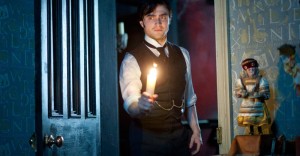The horror genre is littered with stories of haunted houses, from the 1963 classic The Haunting to the more recent Insidious and Paranormal Activity series, but rarely is the English countryside seen as it is in James Watkins’ The Woman in Black.
Based on the 1983 Susan Hill novel of the same name, the film follows Arthur Kipps (Daniel Radcliffe), a lawyer, widower, and father, as he tries to save his job by taking an assignment in rural England. Upon his arrival, he finds the townspeople avoiding him and reluctant to aid his investigation of the finances of the deceased Alice Drablow. It becomes clear that they aren’t protecting themselves but their children from a presence that haunts the town. The mystery deepens as Arthur reaches the Drablow estate, an isolated embankment of barren forests and a graveyard surrounded by endless marshes.
Daniel Radcliffe turns in a mature performance as the bewildered lawyer trapped in the middle of an eerie tale of suicidal children. In only his second feature film outside the realm of Hogwarts, Radcliffe manages to make the audience forget his past of wizardry and mischief and announces himself as an actor growing in stature and confidence. His piercing blue eyes and pale complexion make him suitable for such a role, and he doesn’t look out of place when walking down a dark corridor wielding an axe instead of a wand. Why Radcliffe chose such a role as his first after the final chapter in his Harry Potter legacy isn’t obvious, but he demonstrates the ability to go beyond his years as he portrays a grieving father.
With director James Watkins (Eden Lake) at the helm, we are given a visually striking period piece that provides thematic relevance and entertaining scares. Retaining the mysterious nature of the novel (and its subsequent adaptations of plays, radio broadcasts, and a made-for-TV movie), the film manages to create an effectively foreboding atmosphere. Watkins uses the darkness and prominent contrasts to present his titular character, an elderly woman veiled in black who bears a striking resemblance to the antagonist in James Wan’s Insidious. Appearing in shadows, mirrors, and windows, her terror is augmented by the toys that dominate the house.
Marco Beltrami, best known for scoring the Scream series, uses his broad experience to supplement Watkins’ direction to great effect. Nominated twice for an Academy Award for the western 3:10 to Yuma and war film The Hurt Locker respectively, Beltrami sets the tone and allows the setting to solidify in its supernatural, mysterious nature. Writer Jane Goldman takes a break from her frequent collaborations with Kick-Ass director Matthew Vaughn and gives the story a subtle progression, including a 30-minute period with no dialogue save the shrieks of ghosts and the gasps of a perturbed Radcliffe. But as the film progresses, it starts to fall short in the scope of storytelling. Trying to make the audience uncertain and intrigued, Watkins and Goldman actually make them confused and uninterested.
The film’s final flourish doesn’t do justice to the laboured buildup, and the compulsory horror film twist isn’t one that will be long remembered.
In the end, The Woman in Black manages to scare, but also suffers from the shortcomings of the subgenre. Although it’s old-fashioned and lacks the common exploitive nature of modern horror thrills, it’s certainly a refreshing break from the teen slashers and demonic possession that dominate the current trend. It is a decent entry into the long list of haunted house horrors, but one that will be better known for Daniel Radcliffe’s breakout than for James Watkins’ shrieks and squeals.
MMM

